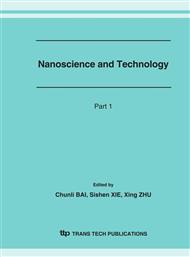p.1455
p.1459
p.1463
p.1473
p.1479
p.1485
p.1489
p.1493
p.1497
Polystyrene/Plasma Treated Clay Nanocomposite
Abstract:
One of weak point of PS/clay nanocomposite is the lack of interfacial adhesion between clay and polystyrene matrix. In this research, the radical sites on the clay surface were induced via the plasma technique. The optimum condition for this process was investigated and used to treat bentonite before grafting styrene on clay structure. The increase of basel-spacing of clay was not noticeable from XRD spectra, but the FT-IR spectra showed characteristic peak of polystyrene implied that the styrene grafting was occurred on the outer surface of the clay. The impact strength is quite improved, especially for the higher ratio of styrene/clay during the grafting step.
Info:
Periodical:
Pages:
1493-1496
Citation:
Online since:
March 2007
Authors:
Keywords:
Price:
Сopyright:
© 2007 Trans Tech Publications Ltd. All Rights Reserved
Share:
Citation:


